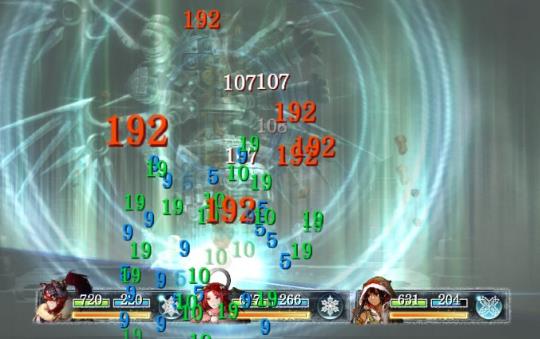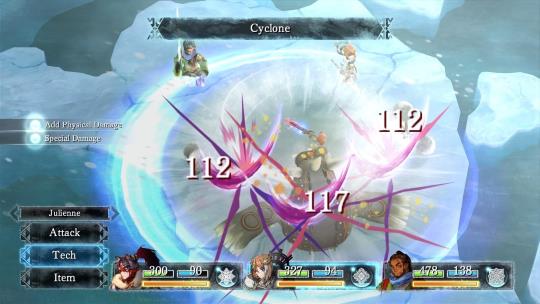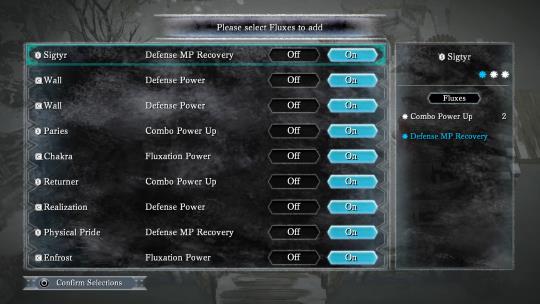The Mechanics of I Am Setsuna

"Wait, huh? How do you make all those numbers appear?!"
The problem with writing an essay is that anything unrelated to your thesis becomes superfluous. The problem with traditional reviews is that they are awkward and scatter-brained, much like a teenager undergoing the changes of puberty. As I prefer the style of the former, I sadly had not spent much time discussing the mechanics of I Am Setsuna for this week’s feature. They are, for the most part, unrelated to the thesis I held regarding the narrative.
Let us correct that oversight here as the mechanics certainly deserve evaluation. Last week I compared the game’s presentation to its 16-bit ancestors, but this fails to truly capture how I Am Setsuna feels to play.
The two fatal weaknesses of I Am Setsuna are in the poor explanation of its mechanics and its dungeon-design. In regards to the former, the game merely gives you a handful of text-descriptions without explaining accurately how these systems work or relate to each other. Certainly an argument can be made in the game’s favor as every tutorial can be revisited via the game’s menu. There are limitation to what a single screen of text can teach, and in the instance of I Am Setsuna’s ever important Momentum some added care would have helped many a clueless player throughout their pilgrimage.
Take the Mario & Luigi games or Super Mario RPG as an example, where the game will run unfamiliar players through a faux-battle to learn the special timing of attack boosts. It freezes the screen in order to indicate when the player must press a button, forcing the player to comply if they wish to go forward. No such effort is taken for I Am Setsuna. Just a single sentence informing the player a button should be pressed, but not fully detailing when.
For a more visual explanation of the system, this YouTube video perfectly captures how to perform Momentum and how it impacts combat. Given that each boss is designed to test the player’s knowledge in Momentum and how it applies to their skills, anyone relying on the game’s basic commands is going to find themselves tight on resources and, in some instances, out of their depth.
As for the dungeons, the best way I can summarize their flaws is to simply state they are JRPG dungeons. Long corridors with occasional branching paths, no hint given as to which might lead to treasure and which leads to the end goal. Extra points awarded to dungeons whose narrative paths permanently cut off the route back, leaving any uncollected treasure locked and hidden away. While I Am Setsuna’s dungeons tend to be “just right” in length, their monotonous repetition and meandering becomes apparent towards the game’s final stretches. Lengthy dungeons that take a great deal of time for no reason but to be longer, eager to convince the player that their incredible length means they are somehow more epic and challenging.
This is not a problem exclusive to I Am Setsuna so much as it is the entire genre. Deep in my heart I await a day where an entire generation of game developers look back upon the Wild Arms franchise and realize these dungeons could have been filled with traps and puzzles all along. Each character is similarly given greater purpose outside of combat, possessing unique tools for specific situations. It gives so much more life and identity to a location than simply filling corridors up with monsters and beasts to fight.

When Momentum and Fluxes activate, they’ll appear on the left side of the screen.
This is another area where Momentum can be rather important – though also a detriment. In order for the player to activate Momentum with their action, they must first have a circular icon fill with light. Once a glowing icon appears, they are able to use Momentum. By approaching enemies on the map from behind, the player is rewarded with a surprise attack and one Momentum charge at the ready. As Momentum at its most basic deals additional damage, this means players can easily come up with memorized attack patterns wiping out all foes in a single round.
Consider how monotonous this might become after a half-dozen floors of fending off foes?
At this point you may be wondering why even bother. If I Am Setsuna cannot even bother explaining its key mechanics to ease the inevitable slog of monotonous dungeon crawling, then what good is it at all?
The answer is that, after learning the depth of the game’s mechanics, there is a certain satisfaction to be found in working it all out. Yes, the game does a poor job cluing the player into its hidden depths. At most you get a single screen of “advice” at every shop, splashing a paragraph of information too early for the player to make any sense of it. Even these explanations are pinching pennies of knowledge, however, as Flux seems a more vague concept given how important its role.
Throughout the game the player will find equipment known as Talismans. Each Talisman can provide a passive bonus that is good for as long as it is equipped, or it can add Flux to your Techs. Each time the player activates Momentum while using a special skill or attack, there is a chance to activate that Flux. After a battle a screen may appear informing the player that this new Flux trait from the Talisman is equipped to that ability.
These traits can run the gamut. Increase in defense, recovery of health or magic, reduction in magic points consumed, etc. You can “stack” these Fluxes onto an ability to increase the odds of their activation. This grants the player a degree of customization, swapping Talismans in and out and choosing abilities based on what sort of Flux abilities they want attached to them. In addition, Talismans also provide additional Spritnite slots available to that character.
Spritnite is a magical material required to use certain abilities. For example, Endir must have the Cyclone Spritnite equipped in order to use that Tech. Think of it like Materia from Final Fantasy VII. While characters will gradually gain more Spritnite slots as they get stronger, Talismans can offer additional slots for commands – combat abilities exclusive to each character – support – more passive abilities that can be used by any character – or a slot capable of taking either type of Spritnite.

New Fluxes have been added to a series of abilities used in combat.
In order to obtain Spritnite, the player must sell materials to the Magic Consortium – a sort of guild located in each town. Materials, rather than gold, are obtained after a battle, collected from fallen beasts and monsters. There are only a limited amount of materials available through the standard killing of foes, and different Spritnite require very specific materials to be sold and stocked by the Magic Consortium in order to be obtained.
This is where the game’s combat becomes less about fighting beasts themselves, but how the player defeats them. Different characters have different elemental properties – Aeterna possesses Time magic, Kir possesses Fire, Julienne possesses Ice, and Setsuna Light – and kills with these elemental properties can yield unique materials. Similarly, slaying foes with linked combinations, by getting overkill, and through use of Momentum will also result in a greater variety of materials obtained.
While the game doesn’t require the player to constantly change their party up, it does provide incentive to experiment rather than coming up with a rote strategy.
So if the player wishes to truly master the game, they’ll be sure to customize their characters and abilities by equipping Talismans with valuable Fluxes. The player will continually use Momentum in order to level those abilities up, while cycling through those attacks and characters regularly in order to obtain more materials. Those materials will not only provide the player with more money, but also more powerful Spritnite so that they can use even more advanced moves and attacks.
It’s not as complicated a system as the Bravely games, and I would say that makes I Am Setsuna more accessible in its ability to be mastered. Unfortunately, as the game provides little information on its own systems, most players may not realize the best way to optimize their party until the end of the game. By that stage it could be too late, or require way too much of a grind just to be slightly stronger than necessary.
It continues to be no wonder that I Am Setsuna is under-appreciated. I just hope more people can give it a second chance.


